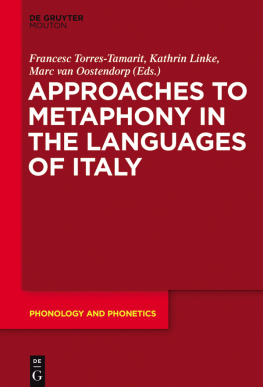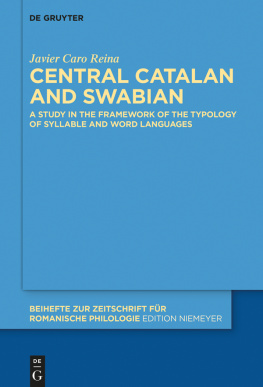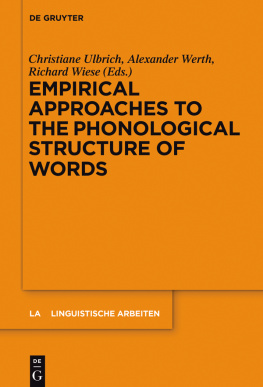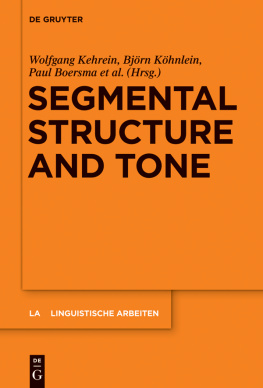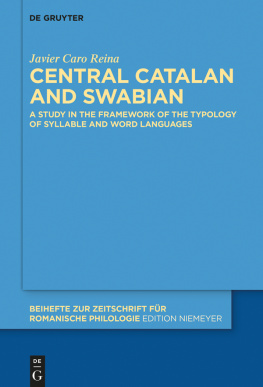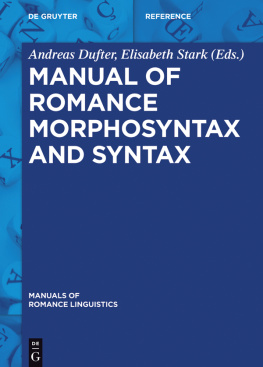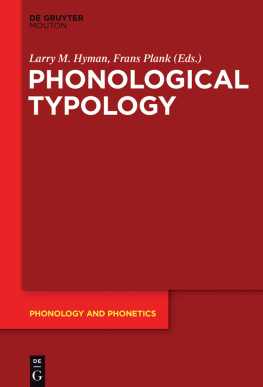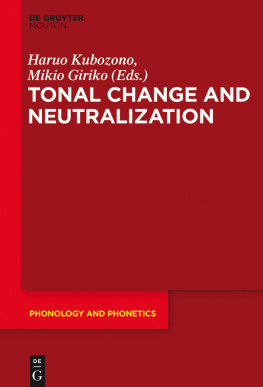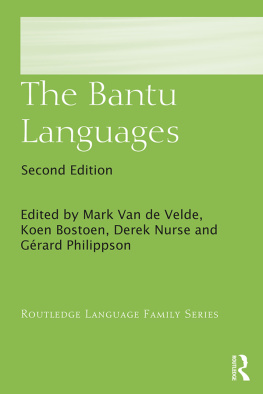Guide

Francesc Torres-Tamarit, Kathrin Linke and Marc van Oostendorp (Eds.)
Approaches to Metaphony in the Languages of Italy
Phonology and Phonetics

Editor
Aditi Lahiri
Volume 20

ISBN 978-3-11-036956-4
e-ISBN (PDF) 978-3-11-036631-0
e-ISBN (EPUB) 978-3-11-039327-9
ISSN 1861-4191
Library of Congress Cataloging-in-Publication Data
A CIP catalog record for this book has been applied for at the Library of Congress.
Bibliographic information published by the Deutsche Nationalbibliothek
The Deutsche Nationalbibliothek lists this publication in the Deutsche Nationalbibliografie; detailed bibliographic data are available on the Internet at http://dnb.dnb.de.
2016 Walter de Gruyter GmbH, Berlin/Boston
Typesetting: Compuscript Ltd., Shannon, Ireland
www.degruyter.com
List of contributors
Andrea Calabrese, University of Connecticut
Stefano Canalis, University of Padua
Roberta DAlessandro, Leiden University
Mirella De Sisto, Meertens Institute
Mirko Grimaldi, University of Salento
Martin Krmer, UiT The Arctic University of Troms
Kathrin Linke, University of Vienna
Michele Loporcaro, University of Zurich
M. Rita Manzini, University of Florence
Joan Mascar, Universitat Autnoma de Barcelona
Sandra Miglietta, University of Salento
Marc van Oostendorp, Meertens Institute and Leiden University
Diana Passino, University Nice Sophia-Antipolis
Leonardo M. Savoia, University of Florence
Francesco Sigona, University of Salento
Francesc Torres-Tamarit, UMR 7023 CNRS/Paris 8
Rachel Walker, University of Southern California
Kathrin Linke, Marc van Oostendorp and Francesc Torres-Tamarit
Introduction
The term metaphony refers to a type of vowel assimilation in Romance, by which a post-tonic inflectional high vowel, or its diachronic remnant in the form of a schwa or even a zero suffix, causes raising ofat leasta stressed vowel belonging to the root.
Even this short description may remind the reader that a proper theoretical description of the phenomenon involves the understanding of several important areas of linguistic theory: we have to understand at least what the internal structure of vowels is, how vocalic properties can spread, what the potential influence (and representation) of stress is, how morphological propertiesbeing part of a root or a suffixcan codetermine phonological behavior, and how historically complex phenomena can get an (opaque) representation in current grammar. Furthermore, since the phenomenon shows up in different ways in different dialects, understanding metaphony potentially enhances studies on language variation and typology.
The phenomenon is currently best attested in the Romance languages and dialects of Italy. Although still operative in Northwestern Romance varieties in Spain (Cantabrian Spanish, Asturian, Galician), Iberian metaphony is recessive (see Penny 2009 for a descriptive overview). In Italy, however, metaphony is widespread and pervasive across most varieties. Italo-Romance is thus a good empirical domain for studies on metaphony in general.
Although several articles present extremely interesting and some of them even new data, the emphasis of the present volume is on theoretical issues, and our aim is mostly to contribute to theoretical understanding of the phenomena at hand. Several of these phenomena are addressed in the different papers of this book; we distinguish between the morphosyntax-phonology interface, the ontology and representation of phonological primes, phonological opacity, the relation between diachrony and synchrony and between grammar and the lexicon. Each of these will be briefly discussed in turn in this volume.
1Morphology-phonology interface
One important issue is how morphology affects the process at hand. Metaphony typically (or even always) means that an affix influences the phonological shape of the stem. In this respect it is different from so-called root-controlled vowel harmony in languages like Turkish, in which a phonological feature spreads from the stem to the affixes.
Furthermore, given the fact that the process only involves some affixes and not others, one has to decide how this kind of specific behavior of individual affixes can be represented in the grammar: should it be done by assigning specific phonological properties (e.g. floating features) to some affixes, or rather by formulating the process itself as being sensitive to morphology? Or should the whole process be called morphological, with some kind of heavy stem suppletion that is sensitive to certain morphemes?
Possibly, there is no theory-neutral way to decide on these questions; whether or not we find any answer to any of these questions plausible will depend at least to some extent on our other views on the organization of the grammar and the division of labor among its various components. The phenomenon can therefore work as a testing ground for those different sets of assumptions.
Different approaches to these and related questions are found among the papers in this volume. Calabrese, in his chapter On the morphophonology of metaphonic alternations in Altamuro , argues against analyses based on abstract representations such as floating features to represent the phonological exponent of specific morphemes, and against suppletion to account for opaque metaphonic alternations due to historical processes of reduction. His proposal is couched in the framework of Distributed Morphology and resorts to phonological rules that operate on specific morpheme exponents.
Mascar, in his chapter On the typology of metaphony/stress dependent harmony , argues instead in favor of floating features to account for morphologized metaphonic systems. According to the structure of the metaphonic trigger, Mascar distinguishes between morphemes that consist of a single floating feature or a set of features (which he calls featural affixation), morphemes that consist of both segmental and floating material (segmental and featural affixation), or just a phonological element encoding no relevant morphological information (phonological harmony).
While Calabrese and Mascar thus each argue for an approach to metaphony that is at least partially morphologically informed, DAlessandro and Van Oostendorp, in Abruzzese metaphony and the | A | eater , argue for considering metaphony to be a purely phonological phenomenon, which is blind to all morphological and lexical information. They develop a representational solution to metaphony in Ariellese in which the |A| element belonging to the stressed vowel is detached from its original position and linked to a final empty mora that is the phonological exponent of [plural] and of the feature bundle [masculine, plural]. The morphology thus only influences phonology indirectly, by the fact that some morphemes take a funny phonological shape.
Manzini and Savoia, however, suggest in Which syntactic information gets interpreted by phonosyntactic processes? Evidence from /u/ propagation in Southern Italian dialects that the externalization component of a minimalist grammar needs to read syntactico-semantic representations in the light of harmony processes triggered by /u/ in Southern Italian dialects. Based on the metaphony process in the dialects under their discussion, they thus suggest a reinterpretation of what kind of morphosyntactic information the phonology can see in general.

